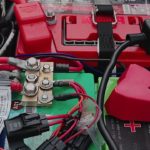Adding a 24 volt System to Your Boat
Is it time to upgrade your trolling motor from a 12 volt to a 24 volt? Our boat rigging expert Darren Jacobson offers this “How To” guide on doing the wiring upgrade yourself.
Each year one of the most often asked questions is “How do I convert my 12-volt trolling motor system to a 24-volt system? And can I do it my self?” Yes you can, and the following instructions will assist you in this operation.
 The addition of a 24-volt system to your rig requires the extra battery, new wiring, 2 circuit breakers, miscellaneous electrical connectors, electrical shrink tubing, a trolling motor plug/receptacle assembly and a battery tray. In most cases your boat has been factory prewired for a 12-volt system. Although, it is likely that the current wiring is not either 6 or 8 gauge which is ideal for a 24 volt system.
The addition of a 24-volt system to your rig requires the extra battery, new wiring, 2 circuit breakers, miscellaneous electrical connectors, electrical shrink tubing, a trolling motor plug/receptacle assembly and a battery tray. In most cases your boat has been factory prewired for a 12-volt system. Although, it is likely that the current wiring is not either 6 or 8 gauge which is ideal for a 24 volt system.
The first step in this process is to determine the location for the extra battery. Over the years I have found that battery compartments located near the bow or midship can be modified to house the additional battery. This can be as simple as removing the existing battery/tray and positioning it in a manner which will allow the installation of the second battery and tray. This is also a great time to inspect your existing battery; if it is over 3 years old it should be replaced. Battery companies have spent a great deal of time in the development of trolling motor marine batteries. Trojan for example offers the SCS225, a model which I have found to hold up well under the toughest conditions. Make sure you install a battery equal to the exciting battery in amp/size rating.
After the location and installation of the second battery has been completed, it is time to gather the rest of the needed supplies. If your current wire is not at least 6 or 8 gauge, then you’ll need to replace it. The replacement wiring should be of Marine Grade, which is a great deal more pliable than normal stranded wiring, making wire routing much easier. This type of wiring can found at most quality Marine supply stores. The wiring needed will consist of one black and one red lead slightly longer than your present wiring plus a short “jumper wire” which will run from one battery to the other.
The wire removal and new installation is very simple. Disconnect the present wiring at the trolling motor receptacle and at the trolling motor battery. Secure the new positive and negative leads to the present wiring with electrical tape at the receptacle location. Begin by carefully pulling the existing wiring from the battery storage compartment. This is a great time to call your fishing partner over for a little assistance with the feeding of the new wires. You will find that this is a very effectant method for the installation/removal of your new and old wiring. Please remember to leave plenty of extra wire at each end allowing for any modification that might be required.
With your wire leads is in the proper location it is time to a self-resetting 40 to 50 amp inline circuit breakers on the positive post of each battery. See your trolling motor’s manual for the proper circuit breaker specifications. After the circuit breakers have been installed continue by sliding a piece of shrink tubing material over the wire leads along with the battery terminal connectors. After securing the terminal ends with pliers, slide the shrink tubing over the connectors and use a household hair drier to heat the tubing, which will then conform to the wire/connector. This will help insure quality connections and prevent any moisture intrusions.
Now you can install and wire the new trolling motor plug/receptacle that will accommodate the 24-volt system. Please apply shrink tubing over the connection as done in the previous steps.
Finally it is time to make the 24-volt connection. Proceed by attaching the red wire lead to the positive post of battery #1 and the black lead will be attached to the negative post of battery #2. Continue by attaching one end of the “jumper wire” to the negative post on battery #1 and to the positive post of battery #2. After tightening the battery post wing nuts by hand use a pliers to insure the nuts are secure. Loose battery terminal connections result in a great deal of trolling motor run-ability issues. Loose terminals can cause run-ability problems for your high tech outboards as well. Finish by installing the rubber battery terminal covers over the posts of each battery. Now you have successfully installed your 24-volt wiring system.





